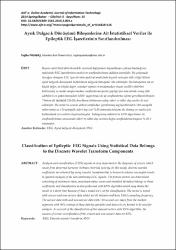| dc.contributor.author | Palabaş, Tuğba | en_US |
| dc.date.accessioned | 2019-10-29T18:00:14Z | |
| dc.date.available | 2019-10-29T18:00:14Z | |
| dc.date.issued | 2014 | |
| dc.identifier.issn | 1309-1581 | |
| dc.identifier.uri | http://www.trdizin.gov.tr/publication/paper/detail/TVRjeE5URTFOUT09 | |
| dc.identifier.uri | https://hdl.handle.net/20.500.12294/2406 | |
| dc.identifier.uri | http://dx.doi.org/10.5824/1309-‐1581.2014.2.003.x | |
| dc.description.abstract | Beynin elektriksel aktivitesindeki anormal değişimden kaynaklanan epilepsi hastalığının teşhisinde EEG işaretlerinin analizi ve sınıflandırılması oldukça önemlidir. Bu çalışmada durağan olmayan EEG işaretlerinin spektral analizinde başarılı sonuçlar e lde ettiği bilinen ayrık dalgacık dönüşümü kullanılarak dalgacık katsayılar elde edilmiştir. Bu katsayılara ait en küçük değer, en büyük değer, standart sapma ve ortalamadan oluşan özellik vektörleri belirlenmiş ve model oluşturmadan sınıflandırma işlemi yaptığı için kısa sürede sonuç elde edebilen k en yakın komşuluk (kNN) algoritması ile de sınıflandırma işlemi gerçekleştirilmiştir. Yöntem 60 dakikalık 256 Hz örnekleme frekansına sahip nöbet ve nöbet dışı veriler ile test edilmiştir. Bu verilerin uzman do ktor tarafından işaretlenmiş segmentlerinden 110 saniyelik nöbet verisi ve 110 saniyelik nöbet dışı veri %50 oranında örtüşme ile alınmış ve analiz için kullanılacak veri setleri oluşturulmuştur. İndirgenmiş vektörlerin kNN algoritması ile sınıflandırılmas ı sonucunda nöbet ve nöbet dışı verinin doğru sınıflandırma başarısı % 83’e ulaşmıştır. | en_US |
| dc.description.abstract | Analysis and classification of EEG signals is very important in the diagnosis of seizure which result from abnormal turnover in brain electrical activity. In this study, discrete wavelet coefficients are obtained by using wavelet transform that is known to achieve successful results in spectral analysis of the non- stationary EEG signals. The feature vectors are determined consisting of minimum value, maximum value, mean and standard deviation belongs to these coefficients and classificat ion is also performed with kNN algorithm which may obtain the result in a short time because of that a model isn't set for classification. The metod is tested with seizure and non -seizure data which are 60 minutes and have 256Hz sampling frequency. The seizure data with and non- seizure data with 110 seconds are taken from the marked segments with 50% overlap of these data by specialist and data sets are formed to be used for analysis. As a result of the classification of the reduced vectors with kNN algorithm, the success of correct classification of the seizure and non- seizure data are 83%. | en_US |
| dc.language.iso | tur | en_US |
| dc.relation.ispartof | AJIT-e: Bilişim Teknolojileri Online Dergisi | en_US |
| dc.identifier.doi | 10.5824/1309-‐1581.2014.2.003.x | en_US |
| dc.identifier.doi | 10.5824/1309--1581.2014.2.003.x | |
| dc.rights | info:eu-repo/semantics/openAccess | en_US |
| dc.subject | Ortak Disiplinler | en_US |
| dc.title | Ayrık dalgacık dönüşümü bileşenlerine ait istatistiksel veriler ile epileptik eeg işaretlerinin sınıflandırılması | en_US |
| dc.title.alternative | Classification of epileptic eeg signals using statistical data belongs to the discrete wavelet transform components | en_US |
| dc.type | article | en_US |
| dc.department | İstanbul Arel Üniversitesi, Mühendislik-Mimarlık Fakültesi, Bilgisayar Mühendisliği Bölümü | en_US |
| dc.identifier.volume | 5 | en_US |
| dc.identifier.issue | 15 | en_US |
| dc.identifier.startpage | 49 | en_US |
| dc.identifier.endpage | 56 | en_US |
| dc.relation.publicationcategory | Makale - Ulusal Hakemli Dergi - Kurum Öğretim Elemanı | en_US |
| dc.institutionauthor | Palabaş, Tuğba | en_US |


















